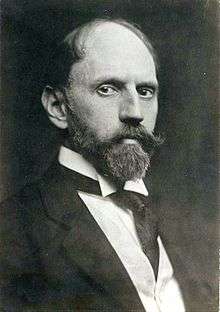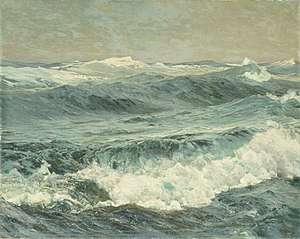Frederick Judd Waugh
Frederick Judd Waugh (September 13, 1861 in Bordentown, New Jersey – September 10, 1940) was an American artist, primarily known as a marine artist. During World War I, he designed ship camouflage for the U.S. Navy, under the direction of Everett L. Warner.
Frederick Judd Waugh | |
|---|---|
 | |
| Born | September 13, 1861 |

Background
Waugh was the son of a well-known Philadelphia portrait painter, Samuel Waugh. He studied at the Pennsylvania Academy of Fine Arts with Thomas Eakins, and at the Académie Julian in Paris, with Adolphe-William Bouguereau. After leaving Paris, he moved to England, residing on the island of Sark in the English Channel, where he made his living as a seascape painter (Havens 1969).
In 1908, Waugh returned to the U.S. and settled in Montclair Heights, New Jersey. He had no studio until art collector William T. Evans (a railroad financier and President of Mills Gibbs Corporation, a dry goods firm) offered him one in exchange for one painting a year. In later years, he lived on Bailey Island, Maine, and in Provincetown, Massachusetts. In 1914, he was a judge of the art exhibit on Monhegan Island, ME during the 1914 Ter-Centenary celebration of the Voyage of Captain John Smith.
Camouflage Service
In 1918, Waugh was recommended to serve as a camouflage artist (or camoufleur) for the U.S. Navy, as a member of the Design Section of its marine camouflage unit (Behrens 2002, 2009). That section was located in Washington, D.C., and was headed by American painter Everett L. Warner (Warner 1919).
According to a biography of Waugh (Havens 1969), “Many large ships, including the Leviathan, were painted according to his designs. Though the enterprise was of course a team effort in which no man played a solo part, he had every reason to be proud of his record. Only one ship with his system of camouflage was lost during the war” (p. 154).
See also
- Wild Weather - seascape by Waugh
- Dazzle camouflage
- Everett L. Warner
- Harold Van Buskirk
References
- Behrens, Roy R. (2002), False Colors: Art, Design and Modern Camouflage. Dysart, Iowa: Bobolink Books, pp. 82–107. ISBN 0-9713244-0-9.
- ___ (2009), Camoupedia: A Compendium of Research on Art, Architecture and Camouflage. Dysart, Iowa: Bobolink Books, pp. 374–376. ISBN 978-0-9713244-6-6.
- Havens, George R. (1969), Frederick J. Waugh: American Marine Painter. Orono ME; University of Maine Press.
- New York Times (1940), “F.J. Waugh Is Dead; Marine Artist, 79” (September 11).
- Warner, Everett L. (1919), “Fooling the Iron Fish: The Inside Story of Marine Camouflage” in Everybody’s Magazine (November), pp. 102–109.
| Wikimedia Commons has media related to Frederick Judd Waugh. |
External links
- Works by or about Frederick Judd Waugh at Internet Archive
- Illustrations from Clan of Munes in new book Rise of the Munes by Palo Santo
- Artwork by Frederick Judd Waugh
- Dazzle camouflage designs by Waugh and other artists
- West Indian marines by Frederick J. Waugh, an exhibition catalog from The Metropolitan Museum of Art Libraries (fully available online as PDF)
- The largest collection of Waugh's works in a U.S. museum is held by the Edwin A. Ulrich Museum of Art at Wichita State University, to which it was donated by the museum's founding donor and avid Waugh collector, Edwin A. Ulrich.